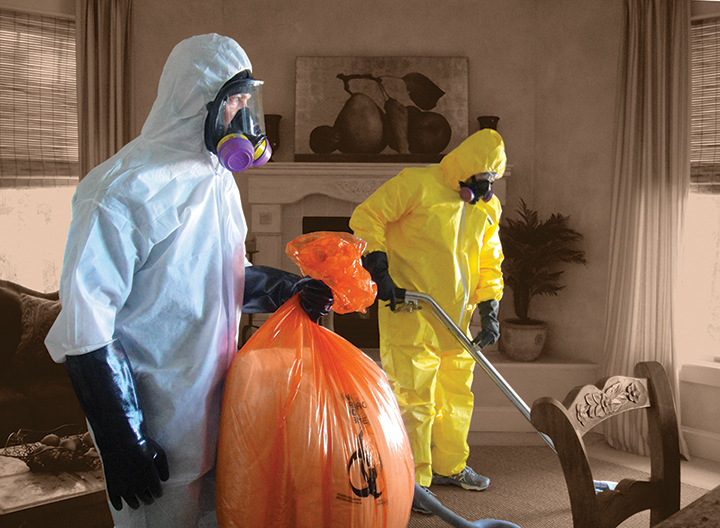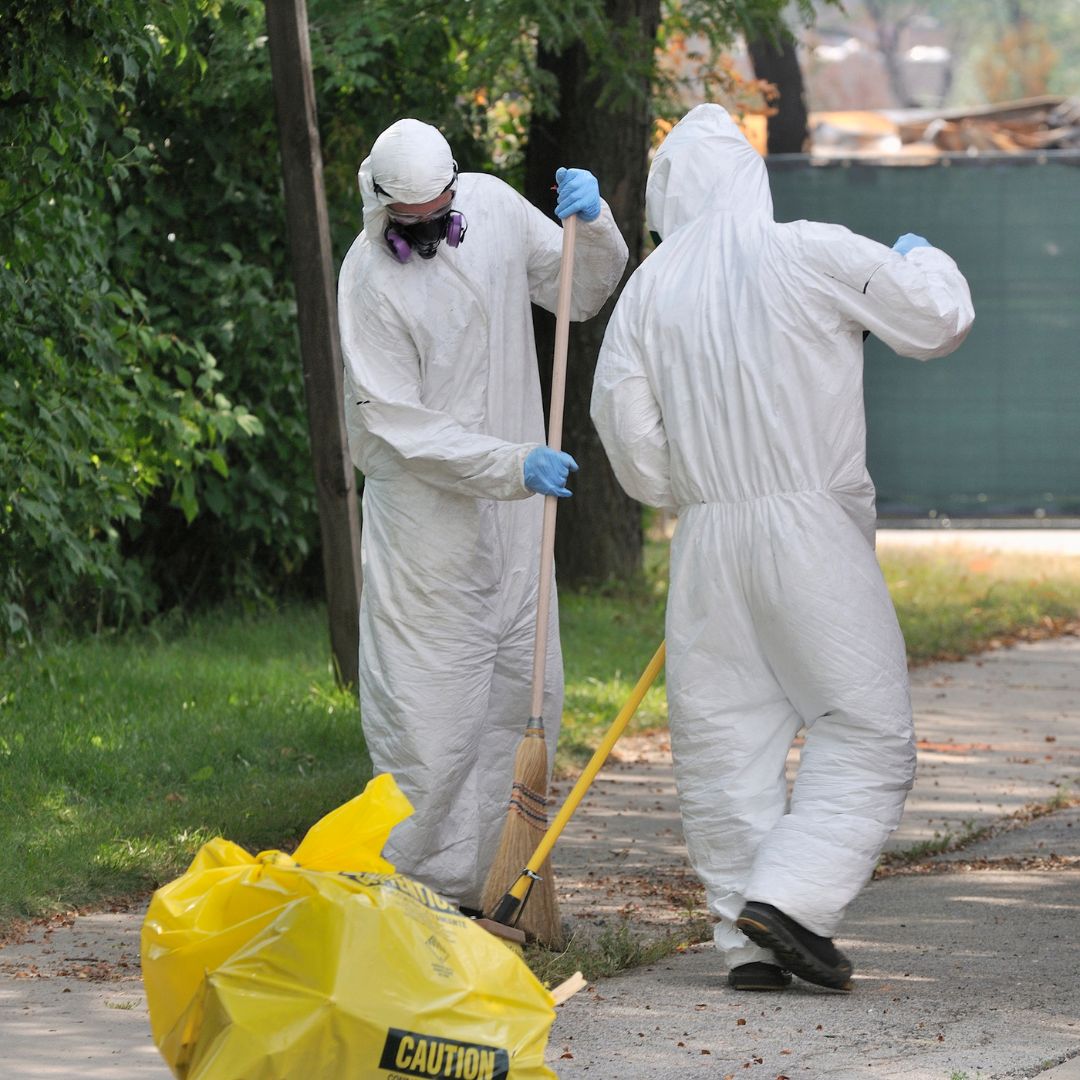Hoarder Cleanup Providers: Fixing Order and Security in Your Home
Wiki Article
Specialist Biohazard Cleaning and Purification for Blood, Bodily Fluids, and Hazardous Products
In the realm of biohazard cleansing and decontamination for blood, bodily fluids, and hazardous products, precision and expertise are paramount. The possible health dangers connected with exposure to biohazards underscore the critical need for careful handling and extensive clean-up. Specialized training furnishes specialists with the knowledge and skills essential to deal with these dangerous circumstances successfully. Nonetheless, it is not merely about cleansing up; the relevance of utilizing correct decontamination strategies can not be overstated. As we browse the detailed landscape of biohazard clean-up, understanding the subtleties of laws, compliance, and the specific devices at play comes to be crucial in making certain a safe and extensive purification procedure.
Health Threats of Biohazard Direct Exposure
Exposure to biohazards poses considerable health and wellness threats that can cause severe consequences for individuals and communities alike. Biohazards incorporate a large range of organic materials, including blood, physical fluids, mold and mildew, microorganisms, infections, and various other potentially transmittable materials. When people enter contact with these biohazards, whether through mishaps, inappropriate handling, or environmental exposure, they deal with the danger of having major illnesses or diseases.Among the primary health and wellness risks connected with biohazard exposure is the transmission of infectious diseases. Bloodborne pathogens such as HIV, hepatitis B and C, and different microorganisms can be existing in biohazardous materials, presenting a direct threat to human health. Breathing in air-borne biohazards like mold and mildew spores or coming into contact with infected surface areas can also cause respiratory concerns, allergies, and other unfavorable health and wellness effects.
Moreover, biohazard exposure can have long-lasting health and wellness effects, with some diseases showing up years after the first contact (Blood Cleanup). Consequently, it is crucial to prioritize correct biohazard cleansing and purification to alleviate these health and wellness dangers and make sure the safety and security of individuals and areas

Specialized Educating for Biohazard Clean-up
When it concerns dealing with biohazard clean-up successfully and safely, specialized training plays an essential function in making certain correct decontamination procedures are adhered to. Biohazard clean-up needs particular knowledge and abilities to properly mitigate threats connected with bloodborne microorganisms, physical fluids, and hazardous products. Professionals learnt biohazard cleanup go through extensive direction on exactly how to safely manage, get rid of, and get rid of biohazardous products to stop contamination and exposure.Specialized training for biohazard cleaning covers a series of vital subjects, including correct personal safety devices (PPE) usage, bloodborne virus recognition, decontamination strategies, and contaminated materials disposal methods. Individuals learnt biohazard clean-up are outfitted with the required proficiency to examine contamination levels, recognize possible dangers, and implement proper clean-up treatments in conformity with regulative criteria.
Continual training and education and learning are vital in the field of biohazard clean-up to remain upgraded on the current purification modern technologies, safety and security methods, and policies. By buying specialized training, biohazard clean-up specialists can efficiently respond to emergency situation cleaning scenarios and safeguard both public wellness and the setting.
Importance of Appropriate Purification Techniques
Using proper purification techniques is essential in biohazard cleanup to successfully eliminate harmful materials and reduce health threats. Effective purification not only ensures the elimination of visible traces of blood, bodily fluids, and other biohazards yet additionally targets unnoticeable virus that may position major health dangers otherwise effectively gotten rid of. click reference By following rigorous purification procedures, educated specialists can dramatically lower the risk of direct exposure to unsafe microorganisms, viruses, and microorganisms that could lead to illness or infections.Appropriate purification strategies entail making use of customized tools and disinfectants that are especially made to reduce the effects of biohazards properly. Thorough cleansing and sanitation of polluted areas are essential to protect against the spread of microorganisms and ensure a risk-free environment for passengers. Additionally, the proper disposal of biohazardous waste following decontamination procedures is important in stopping contamination of other surface areas or individuals.

Equipment and Tools for Safe Cleaning
When dealing with blood, physical fluids, or harmful products, biohazard cleaning specialists count on specialized gear to minimize direct exposure risks and thoroughly sanitize the affected location. Additionally, biohazard cleaning kits having anti-bacterials, absorptive materials, and biohazard bags are made use of to securely contain and get rid of of polluted products.Advanced cleansing tools like hospital-grade disinfectants, HEPA-filtered vacuum cleaners, and misting equipments are utilized to sterilize surface areas and get rid of biohazards properly. Specialized equipment such as sharps containers and biohazard waste disposal containers are utilized to securely take go to this web-site care of sharp items and biohazardous waste materials. By utilizing the right tools and tools, biohazard cleaning professionals can make certain a comprehensive cleanup procedure that focuses on safety and minimizes health threats for both workers and residents of the damaged room.
Laws and Compliance in Biohazard Cleaning
Appropriate adherence to guidelines and compliance requirements is paramount in biohazard cleansing to ensure the safety of both personnel and the setting. Federal government companies such as OSHA (Occupational Security and Wellness Administration) and the EPA (Epa) have developed certain standards for biohazard cleaning procedures to reduce wellness risks and environmental contamination. These policies cover a variety of aspects consisting of the handling, transport, and disposal of biohazardous materials, in addition to the needed training and protective tools needed for employees entailed in the cleanup procedure.Biohazard cleaning companies need to remain updated with these regulations to ensure that their operations fulfill the called for safety and security standards. Failing to follow these policies can cause serious consequences, consisting of fines, lawful activity, and jeopardizing the wellness of people and the atmosphere. By complying with rigorous regulations and conformity steps, biohazard cleaning companies can efficiently reduce dangers and make certain a comprehensive and secure cleaning procedure for all events entailed.
Verdict
In final thought, biohazard cleansing and purification need specific training, proper techniques, and adherence to policies. Exposure to blood, physical fluids, and dangerous materials poses significant wellness risks, making it essential to utilize the ideal This Site equipment and tools for safe clean-up. By following strict procedures and guidelines, experts can successfully reduce the risks connected with biohazard direct exposure and ensure the safety of both themselves and others.
As we navigate the detailed landscape of biohazard cleanup, comprehending the subtleties of regulations, compliance, and the specific devices at play becomes vital in making sure a secure and thorough decontamination process. (Blood Cleanup)
When it comes to dealing with biohazard cleanup efficiently and safely, specialized training plays an essential duty in ensuring appropriate purification procedures are adhered to.Making use of correct decontamination strategies is critical in biohazard clean-up to successfully get rid of hazardous materials and reduce health and wellness dangers. In addition, biohazard cleansing kits containing anti-bacterials, absorbing materials, and biohazard bags are used to safely include and get rid of of infected things.
Federal government companies such as OSHA (Occupational Security and Health Administration) and the EPA (Environmental Protection Agency) have established particular standards for biohazard clean-up treatments to decrease health and wellness risks and ecological contamination.
Report this wiki page